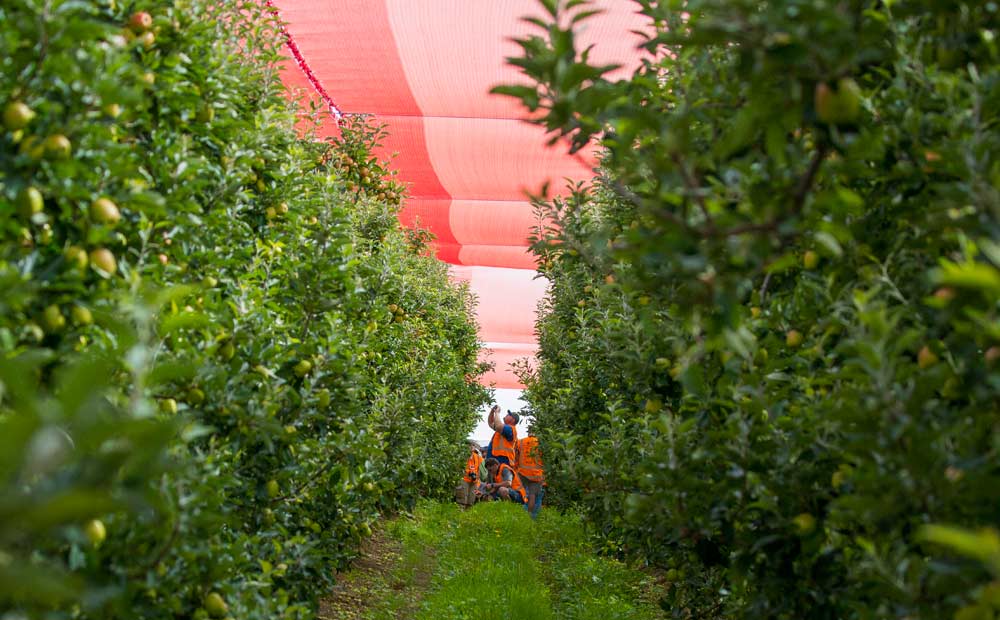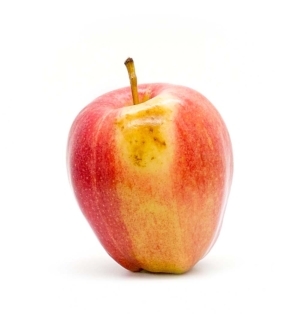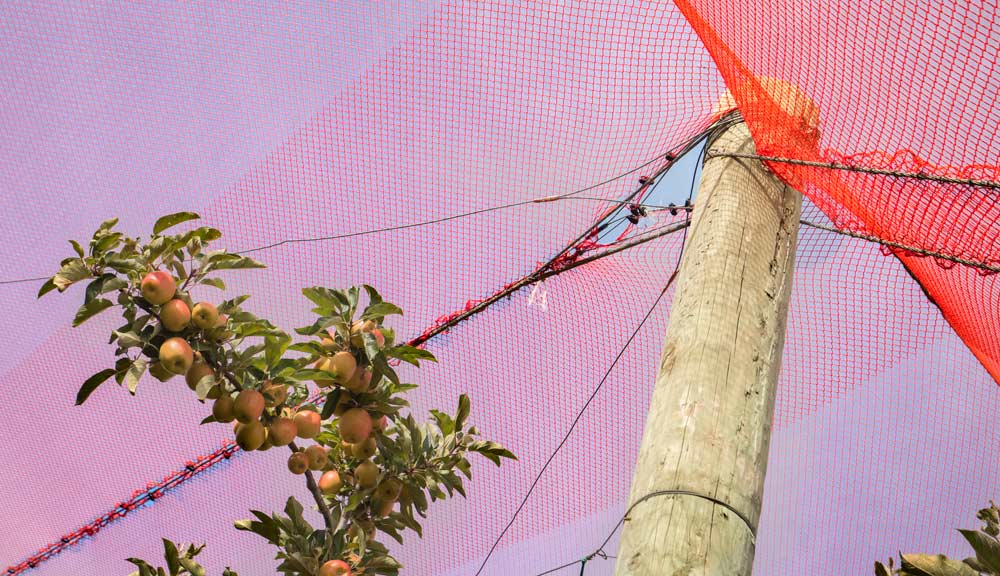
Keith Veselka, from Yakima, Washington, takes photos of red colored netting covering part of Fairfield Orchard in Motueka, New Zealand during the 2018 International Fruit Tree Association New Zealand Study Tour on February 19, 2018. (TJ Mullinax/Good Fruit Grower)
Apple growers across the globe have deployed netting to protect their crops from hail damage, yet more growers are increasingly installing it to protect fruit from sunburn during periods of high temperatures.
The latter reason could become more pressing as temperatures rise in key fruit-growing regions of the world, according to Lee Kalcsits, assistant professor of tree fruit physiology at the Washington State University Tree Fruit Research and Extension Center.

Photoxidative sunburn breakdown apple disorder in Gala. Washington State University, Washington State Tree Fruit Research Commission and Good Fruit Grower. (TJ Mullinax/Good Fruit Grower)
An air temperature of 95 degrees Fahrenheit is the rough threshold for sunburn development in apples. The Pacific Northwest has traditionally experienced five days over 95 degrees annually, on average, (the last few years it’s been closer to 20, he said).
That is forecast to increase to approximately 22 days thanks to the changing climate. Other key areas in the United States — the Midwest and Northeast — could go from two to three days over 95 degrees annually to 30 to 46 days.
“Both hail and sunburn are present in a lot of fruit-growing regions, and hail nets have become a way to control both,” he told attendees of the International Fruit Tree Association conference in New Zealand in February.
Kalcsits shared results of a three-year trial into the use of netting to alleviate sunburn in a 12-acre McDougall and Sons block of Honeycrisp trees on Budagovsky 9 rootstock near Quincy, Washington (Good Fruit Grower shared preliminary results of the trial in “Orchards under cover” in the December 2016 issue — goodfruit.com/orchards-under-cover).
The trial compared three different colors of netting — pearl, blue and red —in an open design where the sides were not closed.
Each of the nets selected reduced light by 20 percent. However, nets change light quality depending on their color.
The pearl netting does not selectively shade out different wavelengths, but red netting shades out more of the blue portion of the light, while the opposite is true of the blue netting.
“That’s important to how plants respond. Plants respond differently to blue and red light for things like color development, for growth,” he said. Knowing already that netting reduces fruit surface temperature, Kalcists wanted to know, “How did that change in spectral quality translate to changes in fruit quality or tree performance?”
Happy trees?
Most Washington growers see very direct light, with strong shadows, and that light intensity is much higher, say 40 percent, than trees can use. But netting reduces that light, in this case by 20 percent, and scatters it throughout the canopy to lower areas that don’t normally get direct light. As a result, the trees are healthier, less stressed in periods of high temperatures and perform better.
The trial showed that, generally, on a hot day, light-use efficiency decreased earlier in the days for uncovered trees, as expected, but the netting delayed that decrease long enough to allow trees to photosynthesize longer in the day, Kalcsits said.
However, growers in low-light environments should consider that they might actually harm their trees by shading them more. “You have to consider the shade percentage you’re choosing depending on the environment you’re growing in,” he said. “If you’re in the Northeast and you want it primarily for hail protection, you want that shade factor to be a low as possible.”
Soil sensors installed at depths of 8 inches (20 centimeters) and 16 inches (40 centimeters) measured soil temperature and soil moisture. Overall, the sensors showed that mean soil temperature from May 28 to Sept. 15, 2015, decreased under the netting, while soil moisture increased underneath the nets during the same time period.

Red, blue and pearl netting hangs over a fourth-leaf Honeycrisp orchard owned by McDougall and Sons near Quincy, Washington, on Aug. 17, 2016, as part of a Washington State University research study into the benefits of netting. (Shannon Dininny/Good Fruit Grower)
Happy fruit?
Because soil water content was higher consistently throughout the season under the nets, trees were less stressed and produced bigger fruit. In 2016, that meant really big fruit of almost 400 grams, he said.
When fruit size is accounted for, there also are more sugars per fruit, the trial showed, with Brix of 14.5 under red and blue nets and 14.7 under pearl nets, compared to 15 for the uncovered control. Uncovered trees had slightly better color, but Kalcsits said he hoped to examine further how reflective material could improve color development underneath the nets.
“It may be a delayed maturity effect, not necessarily reduced color. You get two to three days of delayed maturity, so you might hang that fruit a little bit longer and get the same color,” he said. “It’s just managing those trees differently underneath the nets.”
Anecdotally, he said, growers have estimated two additional boxes per bin being packed from orchards with netting, “which pays for itself in two to three years.”
“So there might be slight reductions in color, but there are other improvements in fruit quality and storability that help the packout,” Kalcsits said.
Overall, netting of any color improved the environmental conditions in the orchard and improved fruit quality, he said, but growers will need to consider how much shade they need to use and how best to engineer it to ensure it remains standing — and to reduce costs. •

Large timbers are used in one of Fairfield Orchard’s Jazz apple blocks to suspend red colored netting in Motueka, New Zealand. (TJ Mullinax/Good Fruit Grower)
Netting and fruit quality
How does orchard netting affect tree growth and fruit quality? Here’s a snapshot of a three-year trial led by WSU assistant professor Lee Kalcsits:
—Strong reductions in sunburn, equivalent to what a grower might see in an orchard with evaporative cooling.
—A small decrease in fruit color if the shade percentage of the netting is too high. Growers should tailor their shade percentage to their growing environment.
—Increased photosynthesis.
—Increased canopy fill-in.
—Increased light use efficiency, another factor to consider when determining shade percentage of netting.
Things to consider:
—Labor for deployment postbloom and retraction after harvest.
—Design, whether you want to retrofit or only install in new orchards. Retrofitting is much more expensive and labor intensive, and overall installation cost is a huge factor, ranging from $3,000 to $12,000 per acre depending on type and system.
—Engineering is essential. Growers need to make sure engineering is really “spot on” and done by a professional, Kalcsits said, “because you can run into some serious problems if it’s not.”
—by Shannon Dininny
Correction
Photo captions published in the print version of this story on April 15, 2018, pages 3, 28 and 31 misidentified a Motueka, New Zealand, orchard as Birdhurst Orchard. The correct name is Fairfield Orchards.
Good Fruit Grower regrets the error.






Leave A Comment